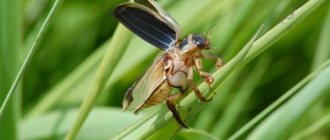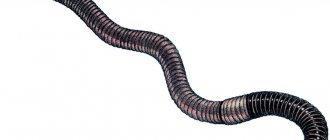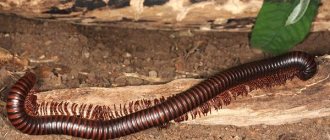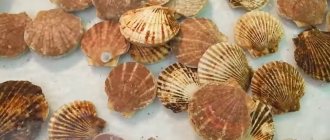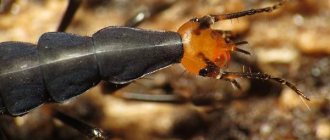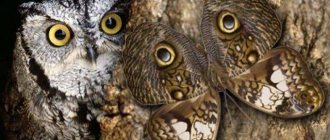What kind of life do insects lead?
Despite the fact that these insects spend a significant part of their time in the water column, they breathe air, which enters the body through spiracles located on the sides of the abdomen.
From the spiracles, tracheal tubes pass through the entire body of the beetle, and breathing sacs are located in the chest. The movement of air in the trachea is created by the rhythmic actions of the abdomen. To replenish its air supply, the swimmer exposes the back of its abdomen above the water. One portion of air lasts him 8–10 minutes. The beetle's body is lighter than water, so it is easy for it to float to the surface. It takes more effort to dive and stay at the bottom. To do this, the swimmer clings to stones or plants with hooks at the ends of its legs. At night, these insects are active, they hunt and make long flights in search of new food.
Before the flight begins, the beetle comes to land, empties its intestines and fills its respiratory sacs with air. As a result, the weight is significantly reduced and the insect can fly. In search of a new body of water, swimmers are guided by the shine of the water surface and often die after making a hard landing on various shiny objects - a metal roof, cars, a glass greenhouse or a window.
Swimming beetles overwinter, burrowing into the ground, into the silt at the bottom of a reservoir, or under leaf litter. They are hunted by birds, fish, crayfish and small mammals. The insect leads a predatory lifestyle.
The swimming beetle feeds on everything that its powerful jaws can hold and chew. It catches and eats snails, tadpoles, small insects and their larvae, and eggs laid in shallow water. In a hungry state, it can attack prey that is several times larger than itself - frogs, newts.
The description of the swimming beetle has much in common with other representatives of this family. This is a fairly large insect - the body length of the swimmer is about 4.5 cm. Most representatives of this family are black in color. There is also a brown coloration of the diving beetle with an olive tint. The long, streamlined body allows the beetle to move easily in the water.
The body of an insect has three parts of the body that are motionlessly articulated with each other: the abdomen, head and chest. Moreover, the insect's head is pressed into the chest, which smoothly passes into the abdomen due to the fused thoracic segments.
Banded swimmer
There are compound eyes on both sides of the head. They are called that because they consist of many simple eyes (about 9 thousand). This allows the insect to distinguish between objects and the plant world around it. The antennae act as organs of touch and smell. The insect's oral apparatus is presented in the form of strong jaws, thanks to which the beetle grabs and crushes its prey. A diagram of the structure of the swimmer and a diagram with captions are presented below.
We suggest you read: Mole cricket insect how to fight
The insect is held on the plant by two front pairs of legs, which have a grasping reflex. The delicate wings are protected by hard elytra, which are characteristic of all beetles of this family. This structure of the diving beetle allows it not only to swim, but also to fly, which helps the insect, if necessary, change its habitat.
On the ground, the swimming beetle moves rather slowly, waddling from side to side. While walking, he moves with his front paws, and the back pair of legs serves for pushing off.
Despite the fact that swimmers are able to fly and move on land, their usual habitat is still water. Therefore, they spend most of their time in it, periodically surfacing. After all, insects breathe atmospheric air. To do this, the beetle exposes the back of its abdomen above the water to fill a special cavity with another portion of oxygen.
With the advent of cold weather, swimming beetles hibernate, arranging cozy bedrooms in the soil for this purpose. They stay there throughout the winter.
Lifestyle
Beetles settle in fresh, stagnant water or bodies of water with weak currents and a lot of vegetation. The fringed swimmer is rarely seen in shallow waters. Adults prefer to leave the pond at night. They make long flights in search of new favorable habitats. Before takeoff, the intestines are emptied and filled with air. When landing, they simply fall head first. The lifespan of a male is 1 year, a female is 1.5-2 years.
Predatory adults attack any prey of suitable size: insects, snails, newts, tadpoles and fish fry. Cannibalism often occurs, with adult beetles eating their own larvae. They consume not only live prey, but also dead animals floating in the water. The green color of the body makes the hunter invisible among the plants. It quickly rushes at passing victims. Insects and tadpoles are torn apart by strong jaws and eaten completely. After feeding, swimmers clean their mouth parts with their front paws.
Beetles are extremely voracious; they rush to available prey, even when well-fed. Promiscuity sometimes leads to death; for example, ladybird larvae are poisonous to them. The fringed swimmer is capable of fasting for 1-2 months.
Breathing process
Adults breathe atmospheric air. To replenish its reserves stored under the elytra, the beetle exposes the rear end of its abdomen above the surface of the water. Through the spiracles, air enters the tracheal system. If it is not possible to surface, swimmers use oxygen dissolved in the water. They expose an air bubble from under the elytra. Gas exchange occurs through its walls, then the bubble is retracted. This is inferior breathing; it does not replace atmospheric air.
Reproduction
The mating period begins in the spring, after emerging from hibernation. The male climbs onto the female and is held on her elytra using flat discs with suction cups on the front legs. During copulation, it has the ability to stick its abdomen out of the water and breathe. Saka is deprived of such an opportunity. If she is attacked by several males, then after the second or third mating she dies from suffocation. The only available way to obtain oxygen is to release a bubble for gas exchange in water. If fertilization occurs in the fall, the resulting sperm retain the ability to fertilize for six months.
In April-May, eggs begin to be laid on the stems and leaves of aquatic plants. Laying is done by young females who have wintered twice. The eggs are placed inside plant tissues using a sharp ovipositor. Up to 30 eggs are laid in one day, and 1000 eggs are laid over the entire period. The clutch is placed on any plants that the female encounters, such as reeds, marigolds, and arrowheads. Clumps of seaweed can be used. The eggs are large, 6-7 mm in size, light yellow. The plant protects them from being eaten and mechanical damage.
Larval development
The hatched larva is completely different from the imago. Coming out of the egg, it falls to the bottom, where it rests for 30-40 minutes. Then it vigorously rises to the surface and takes its first breath using the spiracles at the end of the abdomen. It is born 10 mm long, and by the end of development it increases 5 times. The larva has a flattened head, curved upper jaws, and an elongated prothorax. Three pairs of swimming legs help to move quickly. The abdomen consists of 8 segments. The latter has caudal appendages, anus and spiracles.
The diving beetle larva is no less dangerous a predator than its parents. With strong curved jaws, it securely holds the prey, preventing it from escaping. Through channels located in the mandibles, toxic liquid from the larval esophagus enters the victim’s body. It is rich in enzymes that convert protein into a liquid state. The little huntress sucks out the nutritious pulp, leaving only the skin. At a low temperature of +4°C the larvae stop feeding. Fasting can last for several weeks.
Doll
Approaching the final stage of development, the larva becomes restless and changes in appearance. She crawls onto land and looks for a hole for pupation. The larva builds a spherical cradle from the earth and its own secretions. The pupal phase lasts 2-4 weeks. Young beetles are painted white. Within a few hours, parts of their body first turn yellow, then acquire a dark shade with a yellow border around the edge.
Having emerged from the ground, the swimmer crawls towards the water. An interesting insect is often kept in aquariums. Beetles do not require special care and are unpretentious in nutrition. In captivity they live 3-4 years.
Description of the insect
Swimming beetles are found almost all over the world, and in North America they have even become accustomed to the Arctic zone. Representatives of this family prefer fresh water bodies without strong currents, densely overgrown with plants - ponds, creeks, lakes, swamps. They even inhabit ditches, ditches and deep puddles. On average, the body length of a beetle is 20–30 mm, the largest specimens reach 4–5 cm.
The oval body of the diving beetle is perfectly adapted for movement under water. The beetle has powerful hind legs covered with movable hairs. In the water, he rows them simultaneously, like oars. The middle pair of legs serves to change direction up or down. The body structure is typical of insects: head, chest and abdomen.
The flat, wide head blends smoothly into the chest. On the sides there are complex compound eyes, consisting of 9 thousand simple ocelli. The powerful lower jaw is designed for grasping and chewing food. The mouthparts of diving beetles are of the gnawing type. The role of the olfactory organ is played by long antennae, divided into segments. The photo of the swimming beetle in macro mode clearly shows these anatomical features.
The insect's abdomen consists of segments and is covered with hard, smooth elytra. Some species have a light stripe along the edges of the body. The color of the beetle is dark - brown-green, gray-brown or black.
We suggest you read: Something bites at home and itches
Species of diving beetles
The Latin name for the insects, Dytiscus, comes from the Greek word for “diving.” It accurately characterizes the behavior of the beetle. Among the large family, several interesting species can be distinguished.
Banded swimmer
A common species of swimming beetles, the habitat of which is bodies of water with stagnant or low-flow water. The oval body is black or dark brown. The limbs are orange, as is the edging that runs along the elytra. The adult size is 27-35 mm; a larger subspecies (32-37 mm) is found in the Far East. The male is smaller than the female and has a smooth surface on the elytra. Carnivorous predators attack larvae, fry, tadpoles, and, in the absence of small prey, frogs and fish. They live in Europe, Central Asia and Siberia.
Broad swimmer
The body length of an adult beetle is 35-45 mm. The large, wide beetle is distinguished by its brown or black color with a green tint. The photo shows that a yellow border runs along the edge of the pronotum and elytra of the swimming beetle. The larvae have a long fusiform body and are larger than the imago, growing up to 60-60 mm. Insects inhabit lakes with clear and turbid water. They prefer to keep it close to the shore. They are observed in reservoirs overgrown with sedge, horsetail, cinquefoil, and water lily. The broad swimmer is a rare species. He disappeared in 10 European countries. The beetle is listed in the IUCN Red List.
What does a beetle eat?
Swimming
beetle Swimming beetles are predatory insects. They, like river inhabitants such as the otter or beaver, can pose a danger to entire populations of fish. Small fish, insects, frog tadpoles, mosquito larvae, aquatic worms, as well as dead toads are what the swimming beetle feeds on.
The rather sharp and wide mandibles of beetles are designed to destroy prey, the size of which may seem many times larger than their own. The swimmer is not afraid to attack even a large inhabitant of the reservoir. When attacked, the victim tries to throw off the predator with a sharp movement. But the wound inflicted by the beetle’s mouth begins to bleed, as a result of which the released droplets of blood become a signal for the attack of other swimming beetles.
The Ultimate Predator
The larvae of this species are bad neighbors for all inhabitants of the pond and are one of the most ferocious creatures in ponds. They are figuratively called the tigers of the insect world. On the head of the larva there are large sickle-shaped jaws that can easily pierce prey. They are not intended for chopping food and biting, but they can be firmly attached to the victim.
Through the channels, the larva regurgitates a poisonous liquid, which has a nerve-paralytic effect, from the esophagus into its victim. After the prey stops resisting, the predator regurgitates a new portion, but with strong digestive properties. The latter is capable of destroying tissue into a liquefied mass. Expanding and contracting the pharynx, the larva of the diving beetle, like a pump, sucks out everything that has succumbed to the action of its digestive juice. Having barely finished its meal, the voracious larva is hungry again and immediately starts hunting. Even a hundred tadpoles a day cannot always satiate a predator.
Reproduction
Swimming beetle larvae
The reproduction process of swimming beetles intensifies with the arrival of spring. Having left their hiding places, the beetles go in search of a reservoir. In their new habitat, they begin to choose a partner. During the fertilization process, males are not characterized by signs of gallantry. Having discovered a female, they attack her and hold her with the help of suction cups located on the front legs.
But sometimes one female can mate with several males in a row. In such cases, the likelihood that she will survive is quite low. After all, swimmers are periodically forced to rise to the surface of the water to breathe. Being below at the moment of fertilization, the female is deprived of this opportunity. But the male, being on top, can linger near the surface and get the necessary amount of oxygen.
You should also take into account the fact that the mating process takes much longer than the insect can stay under water without air. Therefore, if the female does not manage to get up in time, she may simply suffocate from lack of oxygen.
After mating, the female begins laying eggs. At one time she is capable of laying up to a hundred eggs, and up to a thousand in a season. She lays her eggs on the stems of aquatic plants in the water. After some time, small larvae are born, which are so voracious that they begin their hunt almost from the moment of birth.
The consequence of the appearance of beetles in fish farms or artificial reservoirs can be the extermination of large numbers of fish. However, there are also creatures who eat the swimming beetle in a pond with great pleasure - these are various invertebrates, large fish, birds and mammals.
We suggest you read: Who eats birds in the forest
The larvae of diving beetles also have enemies. We are talking about an aquatic parasitic insect - an ichneumon fly, which has the strange name of prestwichia. Having discovered the egg of a diving beetle, the female ichneumon lays her eggs in it. The resulting parasite larva will eat the insides of the victim's egg until it turns into a pupa. The already formed adult equestrian is released into the world.
Sexual differences in beetles are expressed in the size and structure of the legs. The female is larger, and the male has plates on the first three segments of his legs, with the help of which he holds the female during the mating period. For diving beetles it occurs in the spring. After fertilization, the female lays eggs in the bottom silt or plant tissue. The larvae hatch after 2 weeks. Outwardly, they look like caterpillars with powerful mandibles and an upturned tail.
The larva is very voracious, and in large quantities destroys eggs, fry and larvae of other insects - mosquitoes, dragonflies, caddis flies. The digestive system is unique - the predator plunges its jaws into the body of the victim and injects gastric juice, which paralyzes the prey and quickly softens the tissues. The insect then sucks up the semi-digested contents.
Before becoming an adult, the larva goes through the pupal stage. At the beginning of autumn, she gets out of the reservoir and builds a cradle on the shore from lumps of soil and plant remains, in which pupation occurs. This process lasts about a month. A few hours after the pupa emerges from the cradle, the soft covers darken and become harder.
The swimming beetle is easy to keep in a home aquarium. Meat or fish are quite suitable as food. It is better to keep decorative fish separately, since the beetle will sooner or later try them anyway.
Keeping in an aquarium
To keep a swimming beetle at home, you need to equip it with housing.
The aquarium in which the insect will live should be spacious, about 60 centimeters in height. The swimming beetle is considered one of the largest on Earth (among aquatic invertebrate arthropods). It is imperative to install a filter in the aquarium; one that is not intended for air supply is also suitable. The swimming beetle (we have already figured out what the predator feeds on) will not die from lack of oxygen, since at any moment it can float to the surface and replenish its air supply.
It is advisable to keep this insect in a closed aquarium, because it flies wonderfully. Once again, I would like to note that you should not keep a swimming beetle with fish, because you have decided to acquire a predator.
Larval development
The larva of the diving beetle, launching its powerful jaws into the body of the victim, releases gastric juice. This composition liquefies the victim's insides, turning them into a liquid state. After which the larva begins to eat, sucking in food through two holes located on the sides of the jaw.
Swimming beetle larvae
After two molts, the young individuals move to land, where they make a shelter for themselves in the damp soil. They pupate in it and remain there to live for 0.5-1 month (depending on weather conditions). After which the swimming beetle emerges from the pupa. It spends about 7 more days underground until its covers become strong. As soon as the beetle acquires a strong shell, it leaves its shelter and heads into the water. The lifespan of a diving beetle is about a year.
Lifestyle and habitat
In nature, it is very rare to find living creatures that can both fly and stay under water for a long time. The swimming beetle lives only in places where there is fresh water and there is no strong current. These beetles fully confirm their name by their way of life. 90% of the time the predator is underwater, tracking prey or resting. Rest is most often combined with replenishing oxygen supplies.
You can see how the beetle lies on the surface with its abdomen up, so it fills its organs with air so that it can then stay under water for some time and return to hunting.
The water beetle swims magnificently, and it’s rare that you won’t see it in any pond. Thickets along the shores of forest lakes and small lakes in water meadows often collect huge numbers of insects. The fast current apparently creates noticeable interference when hunting small predators, and they also have problems when they need to take in air, which is why the habitat is stagnant water.
Although the wings of an insect are adapted for flight, in order to take off, it needs to get to land. The beetle moves on land rather awkwardly, walking in a waddle, swaying from foot to foot. Swimming beetles leave their favorite body of water only in the event of drought and other natural causes of shallowing of the water area.
An interesting feature: swimmers are also active at night. They continue to hunt even in the dark; at this time of day they fly from one body of water to another. Beetles do not see very well at night, which is why they often get into trouble, mistaking surfaces with glare for water surfaces. When diving on wet and shiny objects, swimmers often break.
Its small size and conspicuous appearance should make the diving beetle an accessible prey item for other predators, but it has a defensive weapon in its arsenal. When danger arises, the beetle's glands release a cloudy white liquid that has a disgusting, pungent odor and a sharp, unpleasant taste. This deters even larger predators and is a guarantee of safety.
Relations within the community are quite complex, if not cruel. When two individuals meet, they start a battle for territory, biting and beating each other. Swimming beetles survive the winter cold in cozy burrows, which they make for themselves as frost approaches. At this time of year they sleep.
Relatives
- The closest relatives of diving beetles are divers. This small family unites very small beetles, the size of which does not exceed a few millimeters. They also live in stagnant waters - lakes, ponds, slow rivers, however, adult divers feed on plant foods, despite the fact that they are part of the Carnivorous suborder.
- Water lovers are similar in appearance to swimmers, but they are not close relatives. They are distinguished from swimmers by their uniform coloring, while the body of swimmers often has a bright edging (yellow, orange). Also, water lovers are omnivorous beetles, willingly consuming aquatic plants, worms, and insect larvae. They are similar to diving beetles and phalaropes, which are also included in the Carnivorous suborder. Like divers, they are very small insects, no more than a few millimeters in length. The hind legs of phalaropes have femoral tires. These mini-beetles live along the edges of ponds with standing water.
Class – Insects
Order – Coleoptera
Family Plavuntsy
Adaptability to life
In the aquatic environment, they feel great due to the abundance of food and fast movement . Their hind legs act as oars, which are widened at the ends and covered with dense hairs. The principle of their movement can be compared to the movement of a submarine. They are able to float on the surface of the water due to the fact that their body is lighter than it. When diving, beetles need to expend a lot of energy. Sinking to the bottom in order to stay on it, they cling to some object with the help of two front legs equipped with hooks special for this.
